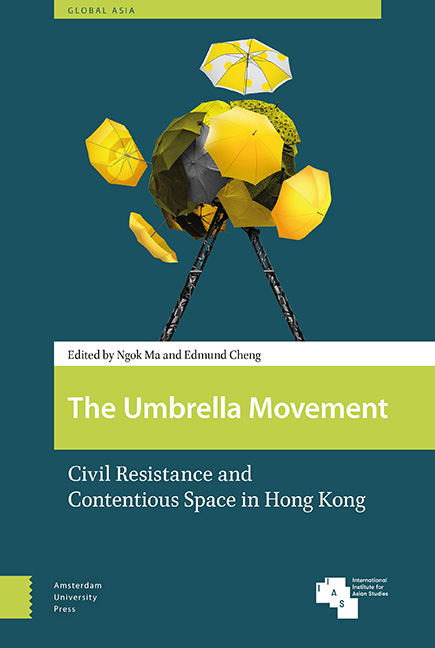Book contents
- Frontmatter
- Contents
- Acknowledgements
- Introduction: Civil Resistance and Contentious Space in Hong Kong
- Part A Trajectory and Contingency
- Part B Repertories and Strategies
- Part C Regime and Public Responses
- Part D Comparative Perspectives
- Appendix: The Umbrella Movement—Chronology of Major Events
- Index
- Publications/Global Asia
11 - The Power of Sunflower: The Origin and the Impact of Taiwan's Protest against Free Trade with China
Published online by Cambridge University Press: 21 November 2020
- Frontmatter
- Contents
- Acknowledgements
- Introduction: Civil Resistance and Contentious Space in Hong Kong
- Part A Trajectory and Contingency
- Part B Repertories and Strategies
- Part C Regime and Public Responses
- Part D Comparative Perspectives
- Appendix: The Umbrella Movement—Chronology of Major Events
- Index
- Publications/Global Asia
Summary
Abstract
This article examines the genesis of Taiwan's 2014 Sunflower Movement and how it contributed to the decisive defeat of the Kuomintang (KMT) in the 2016 election. The KMT's accommodating approach to Beijing since 2008 had deescalated cross-strait military tensions and facilitated closer economic ties. However, the so-called “peace dividend” was not evenly distributed but remained a privilege of the minority who enjoyed political connection. The Sunflower Movement's support came from believers in democratic values and sovereignty, as well as those who expected future joblessness. The widespread perception of threatened democracy and economic victimization constituted the root causes of the Sunflower Movement, paving the way for the historical victory of the independence-leaning Democratic Progressive Party (DPP) in 2016.
Keywords: Taiwan, China, Sunflower Movement, trade liberalization
On 16 January 2016, the Taiwanese elected Tsai Ing-wen as their first female president with 56.1 percent of the popular vote and awarded her Democratic Progressive Party (DPP) a comfortable majority of 68 out of 113 seats in the legislature. This was the second time the Kuomintang (KMT) was voted out of office, but never before had it lost parliamentary control. How could the traditionally independence-leaning DPP return to power in defiance of China's growing international influence? Why did Taiwan's political landscape undergo such massive change?
In the previous presidential election in 2012, KMT's Ma Ying-jeou had succeeded in his reelection bid by a greater-than-expected 6 percent margin over Tsai. Ma's victory was widely attributed to the perception that the KMT was able to maintain cross-strait stability. The campaign strategy of highlighting the “1992 consensus,” which meant that both Taiwan and the mainland belonged to one China, was seen as a successful tactic for mobilizing “economic voters” (Tang, 2013). Learning from their defeat, the DPP's post-2012 evolution indicated a revisionist attempt to modify their pro-independence stance. However, the seemingly irreversible trend of Taiwan accepting Beijing's defined framework was violently disrupted by an unprecedented occupation of the national legislature in 2014.
The so-called Sunflower Movement was a student-led protest opposing the Cross-strait Service Trade Agreement (CSSTA), a bilateral pact to liberalize the flow of capital and manpower in the service sector between Taiwan and China.
- Type
- Chapter
- Information
- Umbrella MovementCivil Resistance and Contentious Space in Hong Kong, pp. 279 - 310Publisher: Amsterdam University PressPrint publication year: 2019



